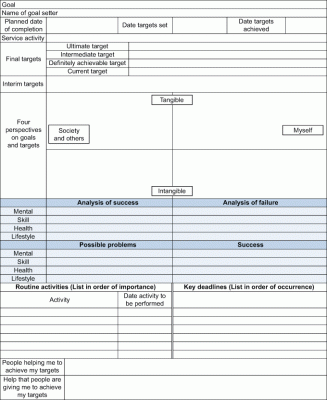A very interesting discussion about the HBR article « Goal-setting: what? why? how? » led me to discover the Harada method (one more !?) built by Toyota as a ‘new’ Lean tool to reduce an « 8th Muda »: wasted human skills.
Norman Bodek for GeorgiaTech presents the Harada method in a short video and a book.
Shachi Marathe presents it more in detail on isixsigma.com :
- « The Harada method deals with the human side of Lean and enables employees to be successful by identifying and embracing a goal or task that helps them move forward »
- « The essence of the Harada method is self-reliance – the confidence and the ability of individuals to develop their skills to the extent that they are virtually irreplaceable. »
- « ... defines three high-level steps that teach self-reliance:
- Pick a goal,
- Develop a timeframe and
- Plan to achieve the goal.
- These steps can be achieved through the application of five “forms” or templates.
- 33 Questions for Self-reliance, that a person answers that gauge how self reliant the individual is. Against each of these questions (i.e., descriptors), individuals should rate themselves on a scale of 1 to 10
- Long-term Goal Form : after assessing their skills with the 33 questions, individuals know what areas in which to improve. The next step is to analyze their goals and purposes with the long-term goal form.
 Open Window 64 Chart : at the center is the ultimate goal; it is surrounded by eight smaller tasks that the indiviual believes are required to support the central goal. Next, for each of those eight smaller tasks, identify eight even smaller goals. Then there will be 64 steps that needs to be followed and finished in order to achieve the ultimate goal
Open Window 64 Chart : at the center is the ultimate goal; it is surrounded by eight smaller tasks that the indiviual believes are required to support the central goal. Next, for each of those eight smaller tasks, identify eight even smaller goals. Then there will be 64 steps that needs to be followed and finished in order to achieve the ultimate goal 
- Routine Check Sheet : this is a daily checklist to help strengthen the individual’s habits. A daily check list should not include more than 10 tasks
- Daily Diary : similar to a typical to-do list. It helps plan individuals’ days to help meet the ultimate goal.
The formal aspect of these tools is classical to Lean tools.
But we find here again the major Value(s) questions, applied to individual human goals !
- « What is it for? » is answered at successive high to low levels : goal > purpose > objective > task > evaluation.
- « What is enough? » is answered by achieving long term goals by daily actions totally in line.
- « Work with the stakeholders » is of course achieved by the user setting himself his goals and checking for their realization. Toyotas’ aim in implementing the Harada method is mentioned by Norman Bodek : each Toyota factory has now to be self-reliant in order for decisions not all to come from Japan … And it led to understand that not only factories have to be self-relian, but every worker !

